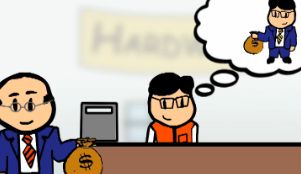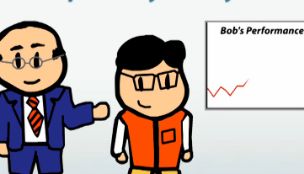Vroom's Expectancy Theory of Employee Motivation - Quiz
Choose your answer and write the correct one down. Then click HERE for the answers to this quiz.
NOTE: The transcript from the video is listed below the quiz for your reference.
1. This person developed expectancy theory
- Victor Vroom
- Clayton Alderfer
- E.L. Thorndike
- Abraham Maslow
- David McCelland
2. Expectancy theory is based on these three components
- effort, performance, reward
- expectancy, performance, reward
- expectancy, performance, result
- effort, praise, return
- expectancy, praise, return
3. An employee who has a high level of expectancy for a valuable reward, also tends to have the motivation to increase performance.
- TRUE
- FALSE
4. The _________ has to be something the employee finds value in, making the efforts worth the perceived worth of the __________.
- expectancy
- performance
- result
- effort
- praise
5. This refers to the level of effort an employee is willing to exert in hopes that the increased effort will result in better performance.
- expectancy
- performance
- result
- effort
- praise
6. The level of this component is based on the strength of the relationship between an employee's behaviors and the rewards they can receive from those actions.
- expectancy
- performance
- result
- effort
- praise
Finding the right equation for motivating employees can be challenging. This lesson explains how expectancy theory is used to motivate employees by increasing the motivation to act based on a set of specific criteria.
Bob Buttkiss
Bob Buttkiss works at a local home improvement store. He's what some might consider a model employee. Bob is always the first one there and the last one to leave. While at work, he puts forth an effort that goes above and beyond his manager's expectations. He is always willing to take on extra projects as well as help his fellow coworkers with their jobs. Bob does not mind working the shifts that everyone else hates, and he does it with a smile. Some of Bob's coworkers think he's just plain crazy to work so hard at a job that pays so little, and others think he's a brown-noser, just trying to make himself look good to the manager.
 |
Expectancy Theory
One of the most widely accepted theories of employee motivation was developed by Victor Vroom in 1964. Expectancy theory is based on the premise that a person will be motivated to put forth a higher level of effort if they believe their efforts will result in higher performance and thus better rewards. If we break down this definition, we can see three key components, which include expectancy, performance and reward.
Expectancy refers to the level of effort that an employee is willing to exert in hopes that the increased effort will result in better performance. For an employee whose review is based on how well they perform their jobs (which most job assessments are), the expectation is that the employee who works harder, such as Bob Buttkiss did in the previous example, can expect to reach a higher level of performance.
 |
Finally, an assessment must also be made as to how valuable the employee finds the rewards to be. The reward therefore has to be something the employee finds value in, making the efforts worth the perceived worth of the reward. For many employees, the prospect of a promotion is a reward that is highly valuable and worth all of the effort that one would need to make in order to earn it. This is certainly true for our friend Bob Buttkiss.
Making Sense of the Equation
While the theory is not all-inclusive of all individual employee motivational needs, expectancy theory can help managers create motivational programs in the workplace. The key to understanding the process behind expectancy theory is determining the relationship between the effort and performance, between performance and reward and between rewards and employee satisfaction. An employee who has a high level of expectancy for a valuable reward also tends to have the high motivation to increase performance. For managers to take advantage of expectancy theory, they must show their employees the connection between their efforts and expectations of performance, then further demonstrate how meeting or exceeding those performance expectations will result in rewards the employee will find desirable.
 |
By aligning performance expectations with rewards, Bob can quickly see what actions he needs to take to meet or exceed those expectations with the anticipation of being promoted some day. Bob's desire to satisfy the need to be promoted is strong enough to make the effort worthwhile, thus he is motivated to perform at high levels.
 |
Lesson Summary
Let's review. One of the most widely accepted theories of motivation was developed by Victor Vroom in 1964. It's known as expectancy theory, which is based on the premise that a person will be motivated to put forth a higher level of effort if they believe their efforts will result in higher performance and thus better rewards.
Expectancy theory is broken down into three components: expectancy, performance and reward. Expectancy refers to the level of effort an employee is willing to exert in hopes that the increased effort will result in better performance. The level of performance is based on the strength of the relationship between an employee's behaviors and the rewards that they receive from those actions. Finally, an assessment must also be made as to how valuable the employee finds the rewards to be. The reward therefore has to be something the employee finds value in, making the efforts worth the perceived worth of the reward.
While the theory is not all-inclusive of all individual employee motivational needs, expectancy theory can help managers to create motivational programs in the workplace. The key to understanding the process behind expectancy theory is determining the relationship between effort and performance, between performance and reward and between rewards and employee satisfaction. An employee who has a high level of expectancy for a valuable reward also tends to have a high level of motivation to increase performance.